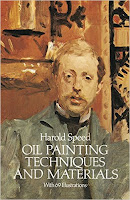Last Saturday I visited the exhibition of Anthony Van Dyck (Flemish/English 1599-1641) at the Frick Collection in New York.
 |
Anthony van Dyck (1599–1641) Self-Portrait, ca. 1613–15
Oil on panel Gemäldegalerie der Akademie der bildenden Künste, Vienna
|
With approximately 100 works on view,
Van Dyck: The Anatomy of Portraiture is the most comprehensive exhibition ever to focus on his portraiture, and the largest exhibition of his work in the US in more than 20 years.
Van Dyck was just a teenager when he entered the studio of Peter Paul Rubens. Several of the prodigy's self-portraits are included in the exhibition.
 |
Anthony van Dyck (1599–1641) Lady Anne Carey,
Later Viscountess Claneboye and Countess of Clanbrassil,
ca. 1636 Oil on canvas The Frick Collection;
Henry Clay Frick Bequest Photo: Michael Bodycomb |
He absorbed the Rubens training into his pores and combined it with an admiration for Titian that he picked up from time spent in Italy. Those influences fused into an elegant style of portraiture that defined the look of portrait painting in England for more than 250 years.
 |
Anthony van Dyck (1599–1641) Portrait Study of Nicholas Lanier,
ca. 1628 Black chalk, heightened with white chalk, on blue paper
Scottish National Gallery, Edinburgh; Lady Murray of Henderland
gift 1860 as a memorial of her husband, Lord Murray of Henderland
The exhibition includes many of his etched and engraved portraits, tiny grisaille likenesses, and a variety of small drawings.
|
Van Dyck would typically do a chalk drawing of the full figure of the subject to capture their characteristic posture and the throw of the drapery. On those preliminary drawings, the face was only summarily indicated.
The drawings show tremendous sensitivity and descriptive ability. They never resort to mindless repetitive crosshatching, and giving no evidence of extensive construction lines, nor is there any sense if hurry or randomness. It's as if he just took his time and got it right the first time.
 |
Anthony van Dyck (1599–1641) Portrait Study of a Man, Facing Right (detail),
ca. 1634 Oil on canvas, with paper extensions along the four sides Private collection |
His practice when painting portraits was to schedule a one- or two-hour session for each person and to paint the face on the final canvas. If the canvas was too big, such as in a big group portrait, he would paint separate oil head studies.
After the hour was up he would dismiss that person and bring in another portrait subject. Between sessions, an assistant would wash his brushes and bring him a fresh palette of paints. By working simultaneously on several portraits, he kept a fresh eye on each.
When it came to the final painting, the master generally only painted the heads. Specialists in his studio painted the costumes, backgrounds, and sometimes the hands. Stand-ins modeled for the figure and the hands.
 |
Anthony van Dyck (1599–1641) Hendrick van Steenwijck the Younger (detail),
ca. 1632−38 Black chalk, gray wash; incised for transfer Städel Museum, Frankfurt am Main |
The catalogue for the show,
Van Dyck: The Anatomy of Portraiture
, is excellent, with numerous closeups and considerable scholarship about his process, all based on primary sources and current research.
Exhibition tips:
• It's OK to sketch in the show, provided you work in a small pad with pencil.
• No photography in the exhibition rooms, and no audio zombies.
• The drawing rooms thoughtfully provide magnifying glasses, so you can get a close look.
• Avoid Sundays, the guards advised me. Because the tickets are free, the crowds are thick.
• The standing portraits are very tall and hung very high. Because of the distance and the inevitable glare, it can be hard to see the faces in the full length portraits, so it might be a good idea to bring some opera glasses.
• There's no café, but you can bring a bag lunch and eat it in Central Park, or find coffee three blocks east at Lexington Ave.
-----
Catalogue:
Van Dyck: The Anatomy of Portraiture
The exhibition
Van Dyck: The Anatomy of Portraiture will be on view through June 5,
Survey the exhibition in expandable thumbnails at their
Visual index
Video lecture by
Stijn Alsteens: "Drawing for Portraits"
Previous post:
Van Dyck Exhibition in New York





















.jpg)










